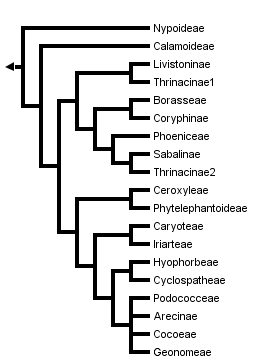Arecanae
The palms
William J. Hahn


This tree diagram shows the relationships between several groups of organisms.
The root of the current tree connects the organisms featured in this tree to their containing group and the rest of the Tree of Life. The basal branching point in the tree represents the ancestor of the other groups in the tree. This ancestor diversified over time into several descendent subgroups, which are represented as internal nodes and terminal taxa to the right.

You can click on the root to travel down the Tree of Life all the way to the root of all Life, and you can click on the names of descendent subgroups to travel up the Tree of Life all the way to individual species.
For more information on ToL tree formatting, please see Interpreting the Tree or Classification. To learn more about phylogenetic trees, please visit our Phylogenetic Biology pages.
close boxIntroduction
The palms are one of the most distinctive groups of land plants and show some of the greatest morphological diversity among all monocots. They are characteristic elements of the tropics and subtropics of the world where they are of considerable economic and ecological importance. Well-known members include the coconut (Cocos nucifera), the date palm (Phoenix dactylifera), the oil palm (Elaeis guineensis), and many ornamental species. The superorder includes 1 family, 200 genera, and approximately 2000 species.
Characteristics
The palms are a readily identifiable group although no consistent morphological synapomorphies are known for the family. Uhl and Dransfield (1987) and Uhl, et al. (1995) have identified two principal diagnostic characters: 1) "woody" stems (due to fibrous sclerenchya, not secondary-growth), and 2) the leaves plicate in bud and later split in most groups.
Discussion of Phylogenetic Relationships
Terminal taxa are based on the Major Groups of Moore (1973) and the updated taxonomy of Uhl and Dransfield (1986, 1987).
References
Dransfield, J, IK Ferguson, & NW Uhl. 1990. The Coryphoid Palms: patterns of variation and evolution. Ann. Missouri Bot. Gard. 77: 802-815.
Hahn, WJ, WJ Kress, & EA Zimmer. 1995. Molecular sequence evolution of the Palmae - A study in deep branch phylogenetics. Amer. J. Bot. 82 (6 - Supplement): 133.
Moore, HE Jr. & NW Uhl. 1982. Major trends of evolution in palms. Bot. Rev. 48(1): 1-69.
Uhl, NW & J Dransfield. 1987. Genera Palamarum: A Classification of Palms Based on the Work of Harold E. Moore, Jr. Allen Press, Lawrence, Kansas.
Uhl, NW, J Dransfield, JI Davis, MA Luckow, KS Hansen, and JJ Doyle. 1995. Phylogenetic relationships among palms: Cladistic analyses of morphological and chloroplast DNA restriction site variation. pp 623-661 in: PJ Rudall, PJ Cribb, DF Cutler, and CJ Humphries (eds.) Monocotyledons: systematics and evolution. Royal Botanic Gardens, Kew.
Title Illustrations

| Scientific Name | Butia paraguariensis |
|---|---|
| Image Use |
 This media file is licensed under the Creative Commons Attribution-NonCommercial License - Version 3.0. This media file is licensed under the Creative Commons Attribution-NonCommercial License - Version 3.0.
|
| Copyright |
© 1997

|
About This Page

Georgetown University, Washington, D. C., USA
Correspondence regarding this page should be directed to William J. Hahn at
Page copyright © 1997
 Page: Tree of Life
Arecanae. The palms.
Authored by
William J. Hahn.
The TEXT of this page is licensed under the
Creative Commons Attribution-NonCommercial License - Version 3.0. Note that images and other media
featured on this page are each governed by their own license, and they may or may not be available
for reuse. Click on an image or a media link to access the media data window, which provides the
relevant licensing information. For the general terms and conditions of ToL material reuse and
redistribution, please see the Tree of Life Copyright
Policies.
Page: Tree of Life
Arecanae. The palms.
Authored by
William J. Hahn.
The TEXT of this page is licensed under the
Creative Commons Attribution-NonCommercial License - Version 3.0. Note that images and other media
featured on this page are each governed by their own license, and they may or may not be available
for reuse. Click on an image or a media link to access the media data window, which provides the
relevant licensing information. For the general terms and conditions of ToL material reuse and
redistribution, please see the Tree of Life Copyright
Policies.
Citing this page:
Hahn, William J. 1997. Arecanae. The palms. Version 01 January 1997 (under construction). http://tolweb.org/Arecanae/21337/1997.01.01 in The Tree of Life Web Project, http://tolweb.org/





 Go to quick links
Go to quick search
Go to navigation for this section of the ToL site
Go to detailed links for the ToL site
Go to quick links
Go to quick search
Go to navigation for this section of the ToL site
Go to detailed links for the ToL site